Key performance indicators.
They help keep teams accountable to certain deliverables and growth goals.
But when you can track 101 of them, how do you know which are critical to understanding whether your content marketing efforts are successful or not?
Well, you first need to understand what the purpose and objective of your content marketing strategy is.
From here you’ll be able to understand which content marketing KPIs are important to track for your business.
It’s important to note that by tracking the right KPIs it will help you execute a more holistic and targeted digital strategy.
So depending on your goals, we’ve laid out nine content marketing KPIs that we believe are worth tracking and growing over time.
Let’s get started:
1. Organic Traffic:
This refers to the number of visitors coming to your website through organic search.
This traffic is important to measure as it allows you insights into whether or not your overall SEO strategy is effective at driving the right kind of traffic to your website or not.
According to research by SEMRush, 67% of companies use organic traffic to measure their content success.
The growth of your organic traffic over time will help grow your website’s visibility and your trust and authority with Google.
If you’re using Google Analytics to analyse your marketing data, you can log into your account, scroll down to “Acquisition” and click on the “Overview” dropdown. It should look something like this:
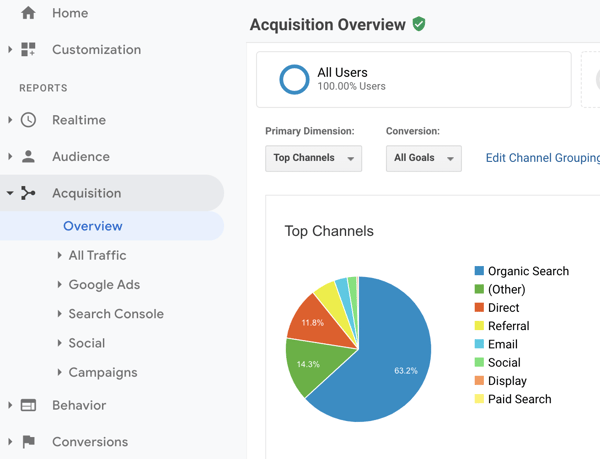
The goal is, of course, to continue to grow this metric through a targeted SEO and content strategy.
2. Organic click-through rate:
Organic click-through rate (CTR) refers to the percentage of searchers that click on a search result.
A study by Backlinko suggests there’s a strong link between Organic CTR and higher rankings in Google.
It’s simple, the higher your CTR, the higher you’re likely to rank.
Why?
Because a high CTR tells Google that your content is addressing what people are looking for.
To track your CTR you can use Google Search Console, it should look something like this:
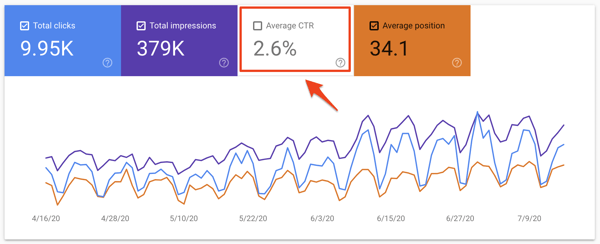
To dive a little deeper you can filter your search by looking at the pages on your website with the highest CTR.

This will bring up a list view of all the pages with clicks and impressions across your website in descending order.
What you want to look for here is pages with low clicks, but high impressions.
These pages are great opportunities for optimisation. They’re getting all the impressions, but may just be missing one or two things to entice a user to click through to your website.
There are a number of things you can do to optimise a page like this from keyword optimisation to more technical SEO like URL structure.
3. Backlinks:
An essential metric to measure as a part of your content marketing strategy is backlinks.
Backlinks are quite simply where one website links back to another.
For example, you will see a number of hyperlinks (just like that one) within this blog to reference various studies or articles that have helped me pull together the research for this article. Those links are backlinks to external sites and directly benefit that sites Domain Authority (DA).
These links then go on to tell Google that the site and its content is trusted and worthy of receiving traffic and clicks.
Google values a high number of backlinks from valuable sites. In fact, it will result in higher organic rankings for your website and content.
It’s, therefore, important to monitor your backlink growth over time.
But how?
We do this in SEMRush and it looks something like this:
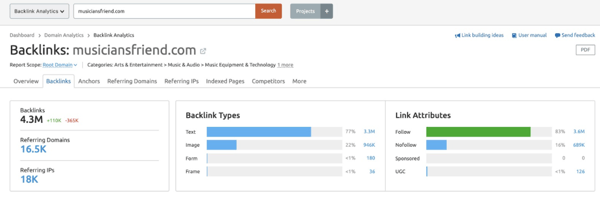
The report tells us how many backlinks we have, what types of links they are, and how many we’ve been able to acquire over a specific time period. In this report, you’re also able to drill down into the site authority and relevance of the websites linking to you.
In a post about monitoring metrics, I think it’s important to note that by monitoring anything it should provide you with insights that help inform strategy.
That’s exactly what monitoring and reporting on backlinks should do for your brand.
It should help inform what content tactics have been successful in achieving backlinks as well as tactics that are not working and need more effort.
The question then is, should link building be a part of your content marketing strategy?
Yes, it absolutely should be!
If your site is young and still has a relatively low Domain Authority (DA), it should be an essential part of building a robust strategy for your business. (But that’s for another post.)
4. Domain Authority (DA):
This is a metric that was developed by Moz. It’s a search engine ranking score that indicates how well a website performs in Search Engine Results Pages (SERPs). It’s a score that’s ranked from 0 - 100, where the higher your DA score the better your site authority and ranking.
You can check your DA using the Moz Bar, it’s a free SEO tool or if you’re using paid software like SEMRush they’re able to generate a similar metric with some of the same determining factors.

The best way to improve your DA is to focus on building high-quality links to your website. Along with a content strategy that’s focused on your domain capabilities.
We recommend monitoring your DA growth every quarter.
Apart from any significant algorithm updates, a strong outreach strategy along with a strong content strategy should see that number slowly ticking upwards.
If you’re looking to create a content strategy, we have a template along with a guide book to help you get started. You can download the template here.
5. Keyword rankings:
If you’re wanting to dominate in organic search, you need to be ranking on page 1 of Google for search terms that are relevant to your products and services.
This means you need to monitor keywords and search terms that are bringing in your organic traffic.
For example, if you have a keyword that’s in position 12, you can look at tactics to help move your ranking to position 10, while you’ve only jumped two positions, that’s the difference between page 1 and page 2 of Google.
We typically use SEMRush to help us track our keyword positioning across certain pages. It looks like this:
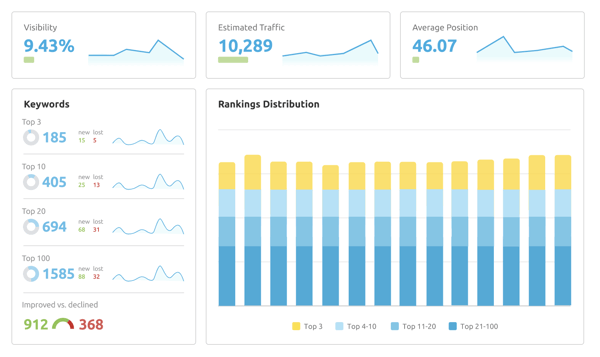
6. Time on-page:
The time visitors spend on specific pages across your website helps you understand what’s resonating with your audience and what’s not.
This metric can be analysed across your website, from your home page to your pricing page to specific blogs on your website, as well as the time spent on your website as a whole.
For this article, I want to focus on the time spent viewing your blog.
If you are using Google analytics to track time on page, it should look something like this: from your GA home page scroll down to “behaviour”, click on “site content”, and finally click on “all pages”.

Once you’ve done this, it will bring up an overview of all your site content. To drill down into just your blog you will need to segment your search by typing “/blog/” into the search bar and click search. It should look something like this:

This view will give you an overall look at your time on page across your entire blog. But it will also give you a drop-down of all your blog content and what each blog’s time on page looks like.
The longer a prospect spends on your website, the more likely it is that they’re engaged with your content. This is a great indicator of content that resonates.
Your goal here is to increase the time a prospect spends on your blog and website.
There are a number of tactics you can use to achieve this, from including video content to creating longer form practical content that addresses your persona’s specific needs.
If you want to increase time on page, you need a content marketing strategy. We created a template that includes a nifty guide book and goal setting sheet to make sure you crush your goals. You can download it here 🚀.
7. Bounce rate:
HubSpot defines bounce rate like this, “the percentage of people who land on a page on your website, then leave.”
Your goal here is to reduce your bounce rate. A high bounce rate might indicate that the content on a specific page might not be resonating with your audience.
But there’s more…
Your bounce rate shouldn’t be analysed in isolation.
It’s important to analyse what your bounce rate looks like from different sources. For example; paid ads often have higher bounce rates than the bounce rates coming from your blog.
If you’re using Google Analytics to analyse this then, there are a number of ways you can find your bounce rate.
From the main dashboard, scroll down to “Audience”, select “Overview”, this will bring up a number of website metrics over a given time period, which you can customise to suit your reporting needs.
From there you can select just the “bounce rate” metric to view in graph format. It should look something like this:

This overview is great but what we really want to do is drill down into your content bounce rate.
In Google Analytics you can scroll down to “Behaviour”, select “Site Content”, then scroll down to “Landing Pages”. Like this:
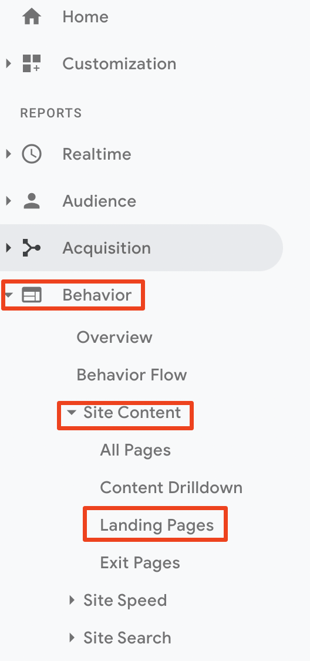
You can then set a secondary dimension to isolate just your blog content. In this case, I set the dimension to “page” and isolated the blog by typing our blog URL in the search bar like this:

Once you're here, you should have all of your blogs listed along with their bounce rate and many other metrics.
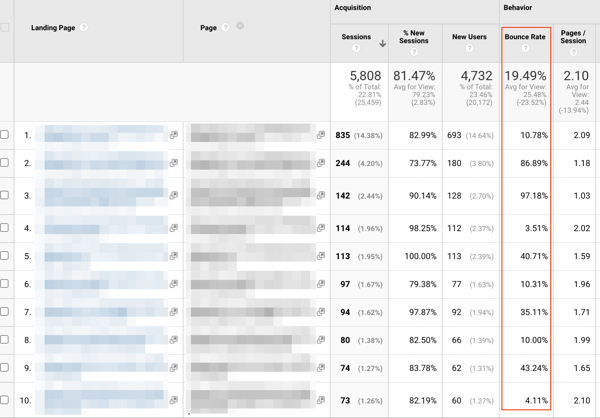
By doing this, you’re able to gain deep insights into what kind of content is performing well for your business and perhaps what content or topics need a little more work.
If you are struggling with high bounce rates there are a number of tactics you can use to help reduce them from optimising for mobile and tablet devices to making sure there aren’t too many distractions on your pages causing visitors to bounce early.
8. Organic Leads
The goal of any website is more often than not to generate leads and influence your business’s sales and revenue targets.
Leads generated organically specifically refers to a prospect who found your company by searching for a specific product, service or question and then converted on your website by taking a specific action like filling out a form or purchasing a product.
[Sidebar] If you’ll forgive me for a moment...let’s just think about that for a moment. As an inbound marketing agency our entire process is centred around creating content that addresses the questions a prospect might have, so then when they type their question into Google and land on your website and convert on it, it means your content was in the right place in front of the right person at the right time. This is a win 🎉. Celebrate it!
Organic lead conversion tells us just how well your content is performing, and conversely what content might need some tweaking.
The goal here is to get those organic website visitors we worked so hard to get to convert on your website. The more you’re able to grow this metric month-on-month, the more you’ll be able to motivate for budget and bigger and better content marketing campaigns.
9. Influenced Revenue
This article would be amiss without understanding how your content marketing efforts impact business revenue.
A simple way of calculating ROI for a content campaign (inclusive of multiple digital content assets) is to take the net profit generated from this campaign and divide it by the full cost of the campaign, multiplied by 100.
This calculation could look something like this:
If we acquired 10 paying customers worth R5000 each and the campaign cost R35 000 to deliver (start to finish) you would see an ROI of:
ROI = (R50 000 - R35 000)/R35000 * 100 = 42.86%
Key Takeaways
Key performance indicators are essential to all of your marketing efforts. They are meant to help track growth and identify opportunities, which should go on to inform your content marketing strategy.
Without them, you’re shooting in the dark. You need the goalposts to help guide your efforts.
Content marketing impacts your bottom line, so it’s essential that you track and measure your efforts in a way that’s sustainable and aids the growth of your business.
Your business may not choose to track and measure each of the metrics listed above, which is fine, but you need to tailor your content marketing KPIs to your growth goals and business requirements.
Only use the metrics that matter to your business.


